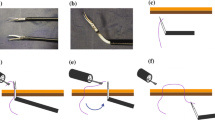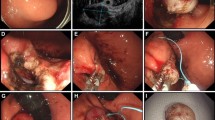Abstract
Background
Endoscopic full-thickness resection (EFTR) is a less-invasive method of en bloc removal of gastrointestinal tumors. In a previous nonsurvival animal experiment, the feasibility of a novel grasp-and-snare EFTR technique using a prototype tissue-lifting device was demonstrated. The objective of this study was to evaluate the safety and outcomes of this EFTR method in a porcine survival model.
Methods
EFTR of model stomach tumors was performed in seven pigs using a double-channel endoscope with a prototype tissue-lifting device through one channel and snare through the other. The lifting device was advanced through the snare loop and anchored to the gastric wall adjacent the model tumor. The lifting device was then partially retracted into the endoscope, causing the target tissue, including tumor, to evert into the gastric lumen. The open snare was then placed beyond the tumor around uninvolved gastric tissue. Resection was performed by delivering an electrosurgical current through the snare. EFTR defects were closed by using tissue anchors. After an intended 10-day observation period, the pigs were euthanized and necropsy was performed.
Results
All seven resections were successful with negative gross margins. No immediate complications occurred. Two defect closures failed during the early postoperative period, leading to infectious complications. The remaining intact closures were complicated by adjacent ulcers, one of which resulted in hemorrhage.
Conclusions
Endoscopic full-thickness resection of gastric lesions using the grasp-and-snare technique is feasible in pigs. In this experiment, complications related to closure were significant. Further evaluation and modification of closure technique is necessary before studying this method of EFTR in humans.








Similar content being viewed by others
References
Rajan E, Gostout C, Burgart L, Leontovich O, Knipschield M, Herman L, Norton I (2002) First endoluminal system for transmural resection of colorectal tissue with a prototype full-thickness resection device in a porcine model. Gastrointest Endosc 55:915–920
Ikeda K, Fritscher-Ravens A, Mosse A, Mills T, Tajiri H, Swain CP (2005) Endoscopic full thickness resection with sutured closure in a porcine model. Gastrointest Endosc 62:122–129
Ikeda K, Mosse A, Park PO, Fritscher-Ravens A, Bergstrom M, Mills T, Tajiri H, Swain CP (2006) Endoscopic full-thickness resection: circumferential cutting method. Gastrointest Endosc 64:82–89
Kaehler G, Langner C, Suchan K, Freudenberg S, Post S (2006) Endoscopic full-thickness resection of the stomach. Surg Endosc 20:519–521
Lee L, Thompson C (2005) Endoscopic transmural resection of gastric wall in a porcine model. Gastrointest Endosc 61:AB232
Chuttani R, Pleskow D, Ornellas L (2006) Endoscopic transmural resection of gastric wall using full thickness plication. Gastrointest Endosc 63:AB241
Ahmed I, Shibukawa G, Groce R, Poussard A, Brining D, Raju G (2007) Study of full-thickness endolumenal segmental resection of colon in a porcine colon model (with videos). Gastrointest Endosc 65:696–702
Elmunzer BJ, Trunzo JA, Marks JM et al (2008) Endoscopic full-thickness resection of gastric tumors using a novel grasp-and-snare technique: feasibility in ex vivo and in vivo porcine models. Endoscopy 40:931–935
Trunzo JA, Cavzzola LT, Elmunzer BJ et al (2009) Facilitating gastrotomy closure during natural-orifice transluminal endoscopic surgery using tissue anchors. Endoscopy [Epub ahead of print]
Sawyer MD, Cherullo EE, Elmunzer BJ et al (2009) Pure natural orifice translumenal endoscopic surgery partial cystectomy: intravesical transurethral and extravesical transgastric techniques in a porcine model. Urology 15 Sept [Epub ahead of print]
Acknowledgment
The authors acknowledge Daniel S. Cutler, Medical Illustrator at the Ann Arbor Veterans Affairs Healthcare Center, for producing Fig. 6.
Disclosures
B. Joseph Elmunzer, Akbar K. Waljee, Jason R. Taylor, Gail M. Rising, Joseph A. Trunzo, Grace H. Elta, James M. Scheiman, Jeffrey L. Ponsky, Jeffrey M. Marks, Richard S. Kwon have no conflicts of interest to disclose pertaining to this manuscript. This study was funded by a NOSCAR research grant. The tissue anchor system was provided by Ethicon Endosurgery through an investigator-initiated product grant.
Author information
Authors and Affiliations
Corresponding author
Rights and permissions
About this article
Cite this article
Elmunzer, B.J., Waljee, A.K., Taylor, J.R. et al. Endoscopic full-thickness resection of gastric lesions using a novel grasp-and-snare technique: evaluation in a porcine survival model. Surg Endosc 24, 1573–1580 (2010). https://doi.org/10.1007/s00464-009-0813-8
Received:
Accepted:
Published:
Issue Date:
DOI: https://doi.org/10.1007/s00464-009-0813-8




